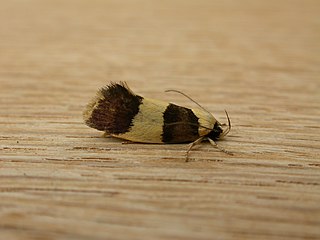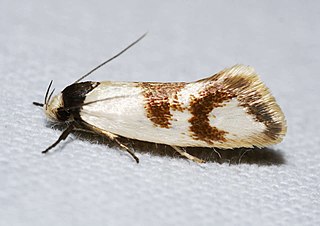Xyroptila peltastes is a moth of the family Pterophoridae. It is found in Australia.
Euprophantis autoglypta is a moth of the family Gracillariidae. It is known from India and Indonesia (Java).
Acrocercops delicata is a moth of the family Gracillariidae. It is known from Java, Indonesia.
Acrocercops cyphostacta is a moth of the family Gracillariidae. It is known from Indonesia (Java).
Acrocercops lophonota is a moth of the family Gracillariidae. It is known from Java, Indonesia.

Telecrates laetiorella is a moth of the family Xyloryctidae. It is known from the Australian Capital Territory, New South Wales, Queensland, South Australia and Victoria.

Agdistopis halieutica is a moth in the Macropiratidae family. It is found from Australia and New Guinea to Fiji.

Pyrgotis eudorana is a species of moth of the family Tortricidae. It is endemic in New Zealand and has been observed in both the North and South Islands. However it is regarded as a rare insect. This species inhabits native forest. Larvae exclusively feed on Muehlenbeckia australis and adults are on the wing from November to April. Adults are attracted to light.

Tingena anaema is a species of moth in the family Oecophoridae. It is endemic to New Zealand and has been collected at Lake Wakatipu, Invercargill and Stewart Island / Rakiura. The adults of the species are on the wing in December.

Tingena apanthes is a species of moth in the family Oecophoridae. It is endemic to New Zealand and found on the North Island. The adults are on the wing from October to December. It appears associated with Leptospermum species and it has been hypothesised that the appearance of the adults of this species imitates faded Leptospermum leaves.

Tingena chloritis is a species of moth in the family Oecophoridae. It is endemic to New Zealand and has been found in the South Island. Larvae of this species feed on leaf litter. The adults of this species are light flyers and are attracted to light.

Tingena horaea is a species of moth in the family Oecophoridae. It is endemic to New Zealand and have been observed in both the North and South Islands. The adults are on the wing in January.

Tingena letharga is a species of moth in the family Oecophoridae. It is endemic to New Zealand and has been observed in Otago. Adults are on the wing in December and January.

Tingena penthalea is a species of moth in the family Oecophoridae. It is endemic to New Zealand and has been observed in Wellington and the Tararua Range. The adults of this species are on the wing from December until February.

Antipterna trilicella is a species of moth in the family Oecophoridae, first described by Edward Meyrick in 1885 as Ocystola trilicella. It appears to be a moth endemic to Australia and confined to the east coast, occurring in Victoria, New South Wales and Queensland.
Antipterna acrobaphes is a species of moth in the family Oecophoridae, first described by Edward Meyrick in 1885 as Ocystola acrobaphes. The holotype was collected in Sydney, New South Wales, in January 1878.
Antipterna diclethra is a species of moth in the family Oecophoridae, first described by Edward Meyrick in 1885 as Ocystola diclethra. Lectotypes for both Ocystola diclethra and Machaeretis niphoessa were both collected in greater Sydney, New South Wales.

Atomotricha sordida is a moth in the family Oecophoridae first described by Arthur Gardiner Butler in 1877. It is endemic to New Zealand and has been observed in the South Island in the Canterbury and Otago regions. The adult female of the species is brachypterous.

Trachypepla photinella is a moth of the family Oecophoridae first described by Edward Meyrick in 1883. It is endemic to New Zealand and has been collected in Wellington, Wainuiomata, D'Urville Island and Christchurch. The preferred habitat of this species is native forest and adults are on the wing from December until February.

Orthenches chlorocoma is a moth of the family Plutellidae first described by Edward Meyrick in 1885. It is endemic to New Zealand and has been observed in the North and South Islands.












